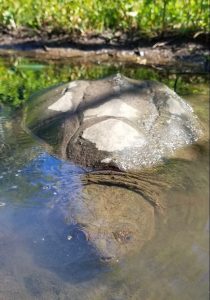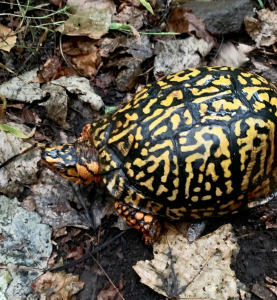How and Where Turtles Hibernate
Not Frozen, Just Cold
How Greenbelt Turtles Survive Winter
By Jessica Kratz
Back in early October, I was asked how turtles spend the winter. I knew they stayed in place, but needed to do more research to better understand how they manage to do so. Here’s what I discovered.
Water temperatures in our ponds remain quite stable over the winter and an ectotherm (cold-blooded animal) sitting in that water will have a similarly stable body temperature. Air, on the other hand, has a low specific heat so its temperature fluctuates, and gets too cold for turtle survival. Water acts as a temperature buffer. It takes a lot of energy to change water temperature.
A cold turtle in cold water has a slow metabolism. The colder it gets, the slower its metabolism, which translates into lower energy and oxygen demands.
Sure enough, beneath the Greenbelt’s Walker Pond, Loosestrife Swamp, and other water bodies, snapping turtles (Chelydra serpentine), painted turtles (Chrysemys picta), and the invasive red-eared slider (Trachemys scripta elegans) are hibernating. Their body temperatures remain relatively stable and will not go below freezing.
 Look closely to see the head of this snapping turtle emerging from a water body in the Greenbelt. Photo: Pawel Pielusynski
Look closely to see the head of this snapping turtle emerging from a water body in the Greenbelt. Photo: Pawel Pielusynski
When turtles hibernate, they rely on stored energy and uptake oxygen from the pond water by moving it across body surfaces that are flush with blood vessels. In this way, they can get enough oxygen to support their minimal needs without using their lungs. Turtles have one area that is especially well vascularized — their butts. The technical term for “butt breathing” is “cloacal respiration.”
Over the winter, as the oxygen is used up, the pond becomes hypoxic (low oxygen content) or anoxic (depleted of oxygen). Some turtles can handle water with low oxygen content — others cannot. But how long is “too long?” Both snapping turtles and painted turtles can survive forced submergence at cold water temperatures in the lab for well over three months. Painted turtles have a high anoxia-tolerance. They use calcium from their shells to neutralize the acid, in same way we take calcium-containing antacids for heartburn.
 Eastern box turtles will begin hibernation (usually starting in October or November) and burrow into loose soil, mud, or abandoned mammal burrows. Photo: Dorothy Reilly
Eastern box turtles will begin hibernation (usually starting in October or November) and burrow into loose soil, mud, or abandoned mammal burrows. Photo: Dorothy Reilly
When spring arrives and turtles emerge from their aqueous, anaerobic hibernation, they are basically one big muscle cramp from the lactic acid buildup (our trail runners can relate!). The turtles are desperate to bask in the sun to increase their body temperature, to fire up their metabolism and eliminate these acidic by-products. So, a sure sign of spring is when you see turtles sunbathing on logs and rocks in the Greenbelt water bodies – gravitating toward the light and air, similar to us humans!
Jessica Kratz is the Greenbelt Nature Center Coordinator, an award winning poet and writer and the author of two children’s books, including “Sleigh Bells in Springtime,” which is based on the spring peeper (frog) emergence.
(Stay tuned for next month’s article on salamanders and their seasonal behaviors).

